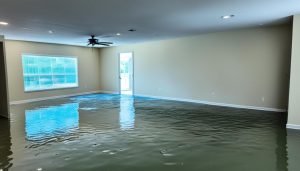Did you know that nearly 14% of Tampa’s properties are at risk of flooding? This is based on a survey by First Street Foundation. Tampa hasn’t seen widespread flood damage lately. But, its flat land and crowded buildings make it prone to flooding. This risk is higher during the rainy season and when storms hit, causing water to gather.
To understand Tampa’s flood risk, we look at rainfall, the land’s shape, and new buildings. People can check their flood risk using the Tampa flood zone map from FEMA’s Flood Insurance Rate Maps (FIRMs). If you live in a high-risk area, getting flood insurance in Tampa is a must. Regular homeowner’s insurance often doesn’t cover flood damage.
Tampa is part of the National Flood Insurance Program (NFIP). This program helps residents get financial help after floods, even if they don’t get federal disaster aid. So, while Tampa hasn’t had big floods before, it’s still important to be prepared to protect your property from future floods. Expert Water Removal is a top flood and water damage restoration company in the Tampa area that can handle flood clean ups and restoration if you need it.
Key Takeaways
- Approximately 14% of Tampa’s properties are at risk of flooding.
- Tampa is prone to localized flooding due to its flat topography and heavy seasonal rainfall.
- Residents should consult the Tampa flood zone map to evaluate their flood risk.
- Standard homeowner’s insurance does not typically cover flood damage.
- Flood insurance in Tampa is available through the National Flood Insurance Program (NFIP).
- Flood risk involves factors like rainfall, topography, and urban development.
Flood Risk in Tampa Bay: Causes and Factors
Tampa Bay faces a high risk of flooding due to natural and human factors. Knowing the main causes helps residents and officials tackle the issue.
Main Causes of Flooding in Tampa
Heavy rains and tropical storms during the rainy season are the main causes of flooding in Tampa Bay. These storms can fill up the city’s drainage systems, causing floods in low areas.
Tidally-Influenced Flooding
Tidal flooding is a big worry for Tampa. Storm surges from tropical storms can raise water levels and flood the area. This makes Tampa more prone to flooding, especially near the coast and rivers.
Additional Factors Determining Flood Risk
Other factors also play a role in Tampa Bay’s flood risk:
- Local rainfall patterns and seasonal changes
- River flow and watershed features
- Tidal surges and storm events
- Regional geography and soil type
- Flood-control measures like levees and drainage
- Effects of urban growth and new buildings on water flow
These factors work together, making it hard to predict and prevent floods. By understanding them, we can work towards a safer Tampa Bay.
Tampa is a city on Florida’s west coast that faces flooding risks. Its low land and closeness to the Gulf of Mexico make it prone to floods. Storms, hurricanes, and heavy rains add to this risk.
The city has a tropical climate with a rainy season from May to October. This brings intense thunderstorms every day. These storms can cause flash floods, filling streets and homes with water.
Urban growth also increases Tampa’s flood risk. More buildings and roads mean more runoff and less ground absorption. This makes drainage systems work harder, often leading to overloads during heavy rains.
Sea-level rise is another big concern for Tampa. As oceans rise, coastal areas face more flooding from tides and storms. This is a big worry for homes near the coast.
To sum up, Tampa’s flood risks come from its location, weather, growth, and sea-level rise. Knowing these factors helps people, planners, and leaders work on reducing flood risks.
Tampa Flood Prevention Measures and Mitigation Efforts
Tampa has taken many steps to protect the city from floods. These efforts are based on detailed studies of local risks and conditions.
City of Tampa’s Flood Prevention Initiatives
The City of Tampa is taking a proactive stance against floods. It provides important info on flood zones and evacuation plans through Alert Tampa. This keeps the community ready for emergencies.
The city also works on reducing stormwater pollution and hosts events to teach about environmental and flood safety. These are key parts of its flood prevention plan.
Community Rating System (CRS)
Tampa is part of the National Flood Insurance Program’s Community Rating System (CRS). This program lowers flood insurance rates for cities that manage floodplains well. Tampa’s involvement in CRS shows its dedication to preventing floods and helps residents save money.
Property Protection Strategies
Tampa has strategies to reduce flood damage to properties. Getting elevation certificates for new buildings in flood-risk areas helps meet safety standards. Following the right rules for changes to properties also helps lower flood risks.
These steps, along with ongoing assessments of flood damage, are key to Tampa’s flood prevention efforts.
Conclusion
Tampa has areas that are at risk of flooding. This is due to its geography, weather, and urban growth. Yet, the city is taking steps to lessen these risks.
There are many flood prevention efforts underway in Tampa. These show the city’s dedication to keeping its people and properties safe. Knowing the Tampa flood zone map helps in understanding flood risks. Following building guidelines can also reduce damage.
For Tampa’s residents, getting flood insurance is key to financial safety. By using FEMA flood maps and staying informed, the community can prepare for floods. It’s important for everyone to join insurance programs and know their flood zones to lessen flood impacts in Tampa.
If you experience any flooding or flood waters to your home or business and need a restoration company in Tampa that can help contact Expert Water Removal








